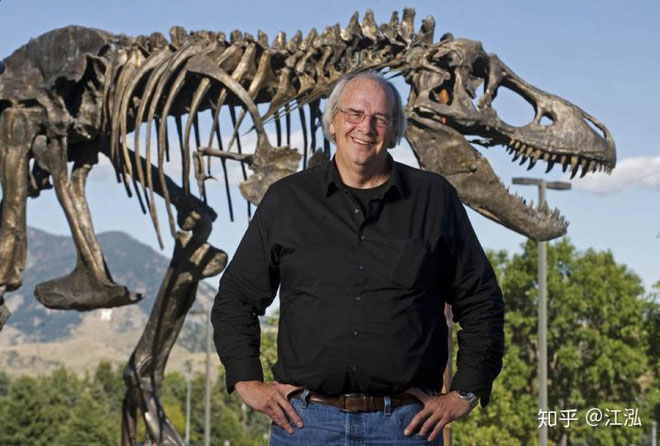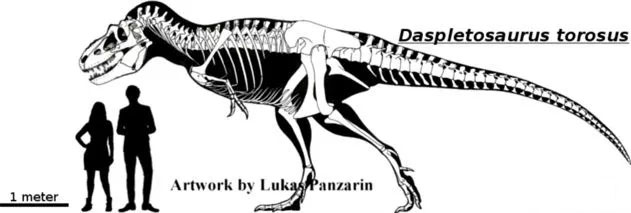Tyrannosaurus Tyrannosaurus relies on her sixth sense to 'love'?
In 2001, paleontologists discovered a dinosaur fossil in Glacier County, Montana, United States. After excavation, the fossil was transferred to the Whyte Museum of The Canadian Rockies for research.
On March 30, 2017, a research paper on the dinosaur fossils found was officially published. The article is titled "A new tyrannosaur with evidence for anagenesis and crocodile-like facial sensory system".
In the study, fossils were classified into the genus Daspletosaurus (a theropoda of the Super Typhoon family). The new species is fully named Daspletosaurus Horneri , with Horneri being named after paleontologist Jack Horner in recognition of his efforts and contributions in research.

The famous paleontologist Jack Horner.
Daspletosaurus Horneri lived at the end of the Cretaceous from 75.1 to 74.4 million years ago, and the formation was found to be the Two Medicine formations formation . They are a huge carnivorous dinosaur with a body length of about 9 meters, about 2.5 meters high and weighing over 4 tons. They possess a fairly large skull with a grace length of 1 meter and two sharp teeth in the mouth with a large eye on the top of the head.
Through fossil analysis and modeling, it can be seen that Daspletosaurus Horneri is a violent dinosaur of extremely good health, their hind legs are long and strong with an appearance almost similar to tyrant dinosaurs. another, while their forelegs are identical to the "little hands" of Tyrannosaurus rex.
In fact, the fossil record discovered in 2001 was not the first fossil specimen of this species to be discovered, instead archaeologists discovered them in the 1970s and at that time they were placed. His name is Daspletosaurus torosus .

Compare adult body size and Daspletosaurus torosus.
These fossils include an almost complete skull, a complete front and hind legs. In addition to bones, this fossil also retains soft tissue fossils on the face and provides valuable information for paleontological researchers.

Paleontologists have noticed that the surface of the dinosaur's skull was filled with gaps, creating an exit for the nerve endings. The authors of the study suggest that 'Tyrannosaurus' dinosaurs may have snuggled their mouths together as an important part of the foreplay before sex. This finding is particularly interesting because it provides new facts for the evolutionary history of the trigeminal nerve that maintains the sensitivity of facial tissues, most of which are soft tissues of the arch. skulls, tissues and mucous membranes of the nose and mouth, teeth and parts of the hard cerebral cortex.
Soft tissue fossils show that the faces of Daspletosaurus Horneri are covered with scales, which indicates that their heads do not have hair and their mouths do not have lip-like parts. Not only that, this fossil sample also revealed much more important information. They have branches of the trigeminal nerve on the scales and on the surface of the nose.
This is similar to modern crocodiles, they also have the same nerves. This is a sensory organ that is very sensitive and can sense vibrations in water. But the nerve branches around the nose of Daspletosaurus Horneri were not used to sense the vibrations in the water, as they are a carnivorous dinosaur that has a completely terrestrial habitat.

They are a carnivorous dinosaur that has a completely terrestrial habitat.
So what exactly is the neural branch on the nose of Daspletosaurus Horneri used for?
Paleontologists have made three predictions:
- Firstly , this can be considered as a temperature sensation. Daspletosaurus Horneri can use their faces to recognize subtle changes in temperature. They will put their heads in the nest to feel the moderate temperature to ensure the eggs can hatch at the perfect temperature.
- Second , detect the prey. Nerve branches around the nose can detect information and change the atmosphere around us, while enhancing the ability to perceive things around them.
- Third , communicate. With sharp sensations around the nose, the Daspletosaurus Horneri were able to communicate by rubbing their faces against each other. This is how crocodiles use their sensors when they mate. In addition to mating, communication between different individuals will also be completed in this way.

The front part of the head Daspletosaurus horneri is covered with a flat protective layer of scales with high tactile sensitivity. Perhaps this protective layer and sensitivities helped the Daspletosaurus horneri to help identify and capture prey. The snouts of these dinosaurs look like those of modern crocodiles.
Precisely because there is a trigeminal nerve with a sensory function on the skin of the nose, it can be said that the dinosaur Daspletosaurus Horneri has a "sixth sense" . Daspletosaurus Horneri and Tyrannosaurus rex are quite closely related, through paleontological research suggests that nearly all Tyrannosaurus species have a "sixth sense" !
- The sixth Sense
- Detection of '6th sense' in mice
- Does echolocation have human sixth sense?
- The sixth sense was very popular
- The truth about the sixth sense of humanity
- Cats and dogs have a 6th sense
- Decoding the sixth senses of animals
- Escape death through my hunch
- Evidence of the 6th sense in humans
- The sixth sense of animals
- New solution to the mystery of '6th sense'
- The 'sixth sense' of the brain detects calories
 Discovered an ancient centipede fossil 99 million years old
Discovered an ancient centipede fossil 99 million years old Discovered bat-like dinosaurs in China
Discovered bat-like dinosaurs in China Discovered a 200-year-old bronze cannon of the coast
Discovered a 200-year-old bronze cannon of the coast Discover 305 million-year-old spider fossils
Discover 305 million-year-old spider fossils